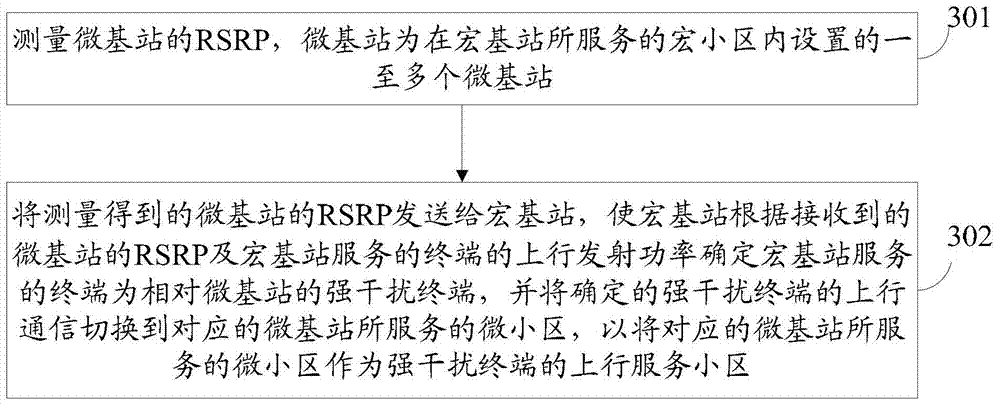Method, equipment and system for selecting serving cell
A technology for serving cells and micro cells, which is applied in the field of communication, and can solve problems such as poor system performance of micro cells, high transmission power, and reduced overall service quality of the network.
- Summary
- Abstract
- Description
- Claims
- Application Information
AI Technical Summary
Problems solved by technology
Method used
Image
Examples
Embodiment 1
[0066] For a heterogeneous network, one or more micro base stations are usually distributed in the macro cell, and terminals served by the macro base station are also distributed on the edge of the micro cell served by the micro base station. These terminals are far away from the macro base station. When the macro base station performs uplink communication, it will cause interference to the micro base station, thereby reducing the service quality of the micro cell. In order to solve this technical problem, an embodiment of the present invention provides a method for selecting a serving cell. From the perspective of implementing the method at the macro base station side, see figure 1 , the method flow includes:
[0067] 101: Determine, among the terminals served by the macro base station, a terminal with strong interference with respect to the micro base station, where the micro base station is one or more micro base stations set in a macro cell served by the macro base station...
Embodiment 2
[0094] For such as Figure 4 In the heterogeneous network shown, there are micro base stations 1 and micro base stations 2 distributed in the macro cell, and terminals 1, 2, and 3 served by the macro base station are distributed on the edge of the micro cell 1 served by the micro base station 1. If the distance is relatively long and the distance to the micro base station is relatively short, the uplink communication with the macro base station will cause greater interference to the micro base station, resulting in a decrease in the service quality of the micro cell. In order to solve this problem, in combination with the content of the first embodiment above, the embodiment of the present invention provides a method for selecting a serving cell. see Figure 5 , the method flow includes:
[0095] 501: The macro base station sends the uplink SRS configuration information of the terminal served by the macro base station to the micro base station, so that the micro base station...
Embodiment 3
[0120] For such as Figure 4 In the heterogeneous network shown, there are micro base stations 1 and micro base stations 2 distributed in the macro cell, and terminals 1, 2, and 3 served by the macro base station are distributed on the edge of the micro cell 1 served by the micro base station 1. If the distance is relatively long and the distance to the micro base station is relatively short, the uplink communication with the macro base station will cause greater interference to the micro base station, resulting in a decrease in the service quality of the micro cell. In order to solve this problem, in combination with the content of the first embodiment above, the embodiment of the present invention provides a method for selecting a serving cell. see Figure 6 , the method flow includes:
[0121] 601: The macro base station receives the RSRP of the micro base station measured by the terminal served by the macro base station and sent by the terminal served by the macro base s...
PUM
 Login to View More
Login to View More Abstract
Description
Claims
Application Information
 Login to View More
Login to View More - R&D
- Intellectual Property
- Life Sciences
- Materials
- Tech Scout
- Unparalleled Data Quality
- Higher Quality Content
- 60% Fewer Hallucinations
Browse by: Latest US Patents, China's latest patents, Technical Efficacy Thesaurus, Application Domain, Technology Topic, Popular Technical Reports.
© 2025 PatSnap. All rights reserved.Legal|Privacy policy|Modern Slavery Act Transparency Statement|Sitemap|About US| Contact US: help@patsnap.com



